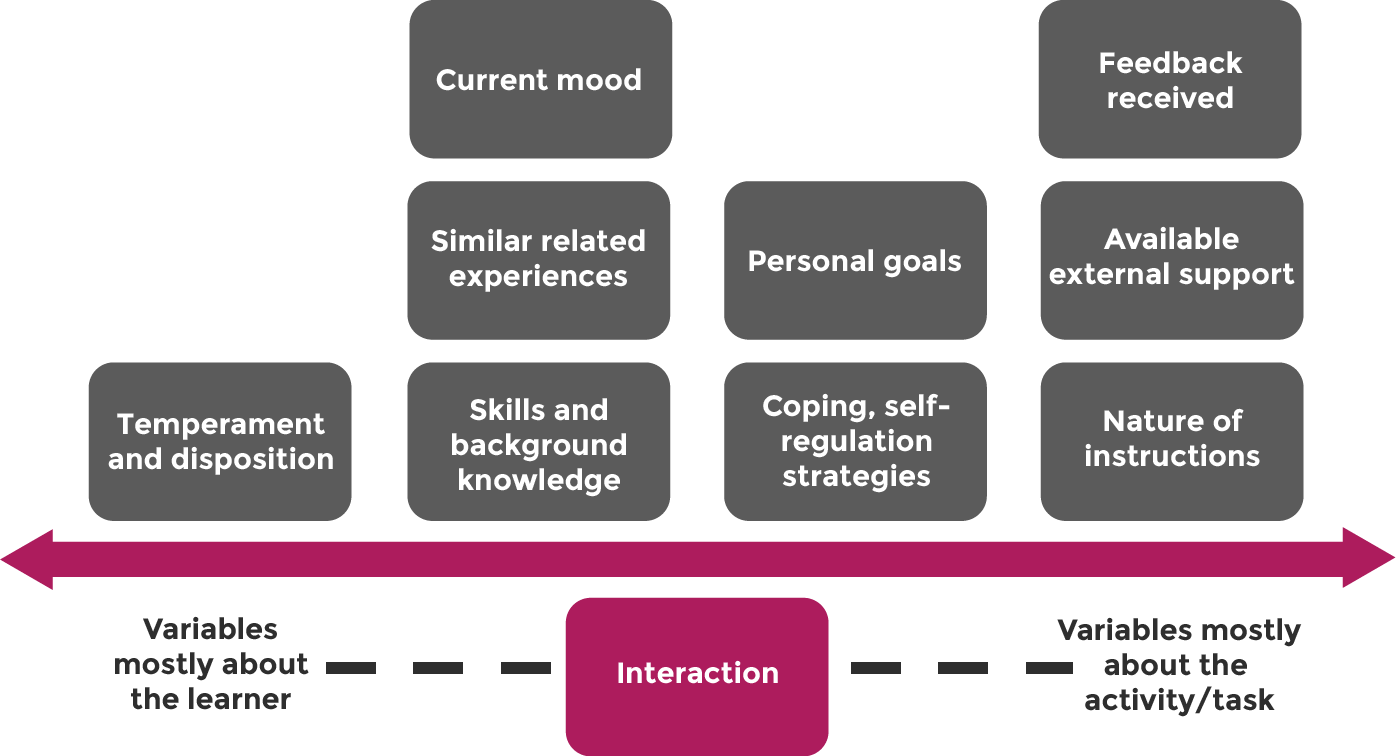Emotion and Learning
What
What is this resource about? This resource provides an introduction to the ways in which instructors can design educational activities to address the interplay between emotion and learning. Read an Example, and learn more about Learner and Activity Variables, and Designing Your Activity.
Why
Why is this important for higher education?
- Emotion and learning are deeply, critically intertwined and the relationship between them affects academic performance.
- The relationship between emotion and learning is rarely part of the planning process when developing courses, nor is it made explicit within the activities themselves and throughout learning environments broadly speaking.
UDL Connection
Provide multiple means of engagement: Offer choice when possible and allow for students to select varying degrees of difficulty within an activity to find the right balance of demands and resources.
Provide multiple means of action and expression: Support learners to cope with challenging activities by modeling specific learning strategies and providing mastery-oriented feedback.
Provide multiple means of representation: Offer choice when possible and allow for students to select varying degrees of difficulty within an activity to find the right balance of demands and resources. This is something about providing multiple means of representation.
Example

As teachers, we strive to increase engagement among our students. For instance, when we think about fostering engagement in a lesson, often times we default to hands-on activities or movies and videos. For many students, lab activities for a science class can pique their interest, achieve ideal arousal levels, and sustain their attention. Yet for others, this activity can trigger emotions that impede engagement as anxiety and over-excitement can both ultimately inhibit learning. Additionally, there are many students who will fall in between these two extremes. As a teacher, it is critical to recognize and plan for the interaction between variable emotional responses and the activity itself.
Learner and Activity Variables
Each student will perceive a learning activity through his or her unique lens. Perception is influenced by a number of variables along a spectrum. On one end are the learner's personal experiences, preferences, disposition, temperament, and academic strengths and weaknesses. These variables reside within the learner and instructors are limited in terms of how much influence they have over these variables. On the other side of the spectrum, there are variables within the activity or task itself that can be adjusted, which include the supports and strategies aimed to address both cognitive and emotional aspects of the experience.
The graphic below shows the general spectrum of variables that a student brings with them into a learning experience (note that this is not a complete list of variables) and variables that the instructor can account for in the design. While there are two ends of the spectrum, the interaction between the learner and the learning activity will determine how these variables play a role. For example, while a learner may approach a math activity with some trepidation based on prior experiences and concern about inadequate skills, she may find that the activity was designed to provide enough support. What started as a negative perception fluidly moves to a more positive response that overcomes the prior negative experience.

Designing Your Activities
There are two primary ways we can address the interaction of learner variables and activity variables through instructional design:
- Adjust the activity/task. Differences in affect and engagement exist not only between students but also within the same student over time as a result of development, context, and the act of learning itself. From the outset, plan for emotional variability and how it impacts interactions with content and tasks. Consider whether an activity assumes certain emotional skill sets or dispositions amongst learners, and design options so that the task remains invitational for students who may be struggling with those necessary skills.
- Support the learner to be able to cope with challenges within the activity or task. Learning is more than task completion. As teachers we strive to develop independent, self-directed learners. Through instruction, we can facilitate meta-cognitive strategies to help learners process information into meaningful knowledge and increase awareness of their own learning.
The three principles of Universal Design for Learning (UDL) offer actionable steps for designing instruction that addresses the interaction of learner variables and activity variables.
Multiple Means of Representation
This principle focuses on the ways in which learners gather facts and categorize what they see, hear, and read (CAST, 2011). Addressing variability in perception encourages engagement and supports comprehension.Adjust the activity/task
Offer alternative forms of information such as diagrams, photographs, storyboards, and multimedia.
For content presented in digital text, allow for tools such as text-to-speech to minimize cognitive demands on decoding, especially for students with dyslexia and English language learners.
Support the learner to cope with challenges within the activity/task
Introduce information progressively with temporary assisstive components or scaffolds to help students manage the content at a reasonable pace.
Pre-teach critical information and emphasize relationships between concepts through multiple representations.
Model ways to solve new problems with previously learned skills and guide generalization of student learning to new contexts by providing supported opportunities.
Multiple Means of Action and Expression
This principle is connected to strategic actions, including planning and performing tasks, organizing and expressing ideas, writing essays, and solving math problems (CAST, 2011). Providing options for how students demonstrate comprehension helps sustain engagement and encourage persistence.Adjust the activity/task
Provide access to assistive technologies for expression.
Adjust activity so that students can express their knowledge effectively and efficiently by including multiple tools for composition (e.g., written expression, voice recordings, multimedia).
Support the learner to cope with challenges within the activity/task
Support executive functioning by modeling goal-setting, selecting learning strategies, and monitoring progress.
Use prompts to promote reflection about work and process.
Guide students through sequences and prioritization.
Model organization strategies and offer solutions to manage information
To monitor progress, embed frequent formative and low-stakes assessments to collect actionable information to guide instructional decision-making.
Give specific targeted and timely feedback about strengths and weaknesses that encourage student persistence and suggests next steps. Make clear that assessment informs instruction, as well.
Multiple Means of Engagement
This principle focuses on how learners can become engaged and stay motivated and whether they feel challenged, excited, and interested in what they are learning (CAST, 2011). Without engagement, learners will struggle to attend to content and make deep learning connections.Adjust the activity/task
Add choice in the selection of activities when possible.
Offer scaffolded challenges that vary in degree of difficulty.
Create learning communities that connect content to interdisciplinary topics and personal interests.
Support the learner to cope with challenges within the activity/task
Set the tone by making it clear that student emotional engagement and motivation matters.
Embed self-checks in task and ask students to rate the difficulty of a task.
Support relevance and persistence through tasks by making the purpose explicit.
Offer clear expectations that support motivation.
Review
Emotion biases our attention, memories, and capacity for rational thought, and is thus a fundamental part of learning processes. As educators, the experiences we design for students must take into account the role emotional variability plays in behavior and academic performance within the same student over time and between students. The UDL principles provide actionable steps for educators to take as we approach course planning and student supports with this variability in mind. By capitalizing on the inclusive power of multiple means of representation, multiple means of action and expression, and multiple means of engagement, we create alternative pathways for achieving learning goals, while maintaining high expectations for our students.
Resource
Watch CAST’s Director of Research, Samantha Daley, give a keynote address on emotion and learning.
Multiple means of representation refers to the what of learning. Because learners vary in how they perceive and understand information, it is crucial to provide different ways of presenting content.
Self-regulation is the ability to strategically modulate one’s emotional reactions or states in order to cope or engage with the environment more effectively.
Affect is the experience of feeling or emotion.
UDL is an educational approach based on the learning sciences with three primary principles—multiple means of representation of information, multiple means of student action and expression, and multiple means of student engagement.
Multimedia refers to the combination of several media (e.g., text, graphics, audio clips, video) to represent content concepts.
Text-to-speech or speech synthesis is the artificial production of human speech and is generally accomplished with special software and/or hardware.
Executive functioning refers to a set of cognitive capabilities, associated with the prefrontal cortex in the brain, that allow humans to overcome impulsive, short-term reactions to their environment and to instead set long-term goals, plan effective strategies for reaching those goals, monitor their progress, and modify strategies as needed.
Assessment is the process of gathering information about a learner’s performance using a variety of methods and materials in order to determine learners’ knowledge, skills, and motivation for the purpose of making informed educational decisions.
Multiple means of action and expression refers to the how of learning. Because learners vary in how they express their knowledge, it is crucial to allow them to express what they know in different ways.
Multiple means of engagement refers to the why of learning. Because learners vary in how they can become interested or motivated to learn, it is crucial to provide multiple ways to engage learners.
